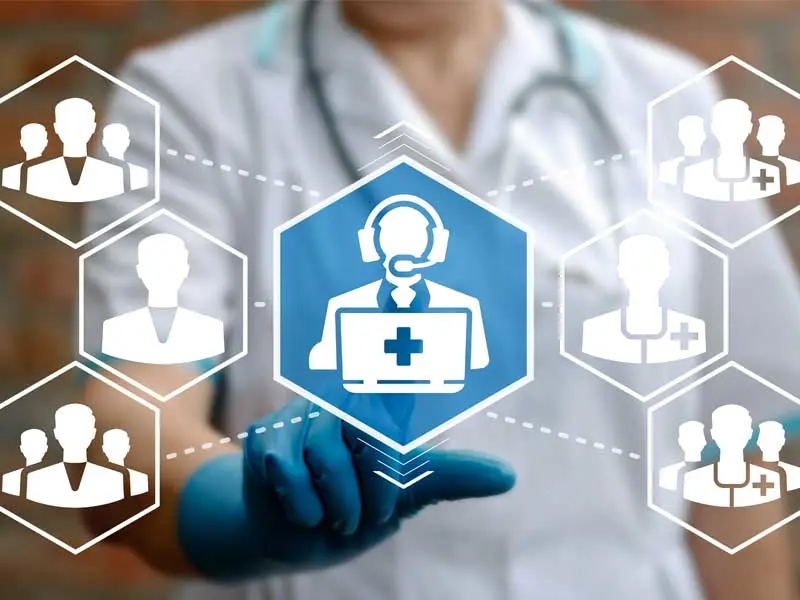- Insights
- Customer Experience
- Article
Five CX lessons from the rise of telemedicine

Think of the last time you visited a doctor’s office before the COVID-19 pandemic.
On average, it likely took you 29 days or more to get an appointment that lasted about 12 minutes. During the appointment, you likely spent most of the visit anxiously tapping your foot as the physician filled out a pile of forms, by hand or on the computer. And then, if you needed a prescription, you waited another 45 minutes at a pharmacy to get your medication.
These averages come courtesy of George Koveos, Senior Vice President of Strategy and Operations at telemedicine provider Ro, who says traditional medicine has typically been a waiting game for many.
Enter the telehealth industry, which includes telemedicine plus all medical services and health education delivered digitally. The industry was already growing before the pandemic to the tune of 34.7% between 2014 and 2019, according to market research firm IBISWorld.
Shortly after widespread coronavirus lockdowns spread across the country, the U.S. federal government announced Medicare telehealth coverage would temporarily expand, lifting restrictions and regulations that had limited its spread previously. Before March, about 11,000 Medicare patients used telemedicine every week. That number has since exploded to 650,000.
More recently, CNBC reported that telehealth is poised to experience an even more significant growth spurt, from around $45 billion in 2019 to more than $175 billion by 2026.
With such rapid adoption, it’s been a challenge for many telehealth providers to meet demand — yet one survey, done by Vivify Health in July, says 80% of patients using telehealth services are reporting having positive experiences. “Ultimately, necessity has been a great accelerator of innovation and adoption,” says Lisa Levine, CEO of the non-profit MAVEN Project, which recruits retired physicians to support medical clinics on a volunteer basis through telemedicine. “The pandemic magnified the use case for telehealth, and it’s a silver lining in the current public health crisis.”
Here are five important lessons from the rise of telemedicine for healthcare and insurance providers that are contemplating their own digital transformation.
Lesson #1: Offer support across channels and modalities
When it started, the “tele” in telemedicine was all about using the simplest technology available to get the best possible outcomes. “Telemedicine 1.0 was all about ‘call your doc,’” says Jamey Edwards, CEO of telemedicine provider Cloudbreak Health, adding that phone visits are still a highly effective but under-appreciated method for receiving care. “Telemedicine 2.0 is all about adding video, since 70% of communication is non-verbal.”
Now, telemedicine integrates an ever-growing set of technologies to create a true omnichannel experience for patients. “Telemedicine 3.0? It’s multi-modality across phone, email, chat, video, fileshare and image sharing,” Edwards says.
The takeaway: Medical care is multifaceted. The tools and channels offered to patients should also be flexible and customizable.
Lesson #2: Meet people where they are
As COVID-19 lockdowns forced people to stay at home and practice physical distancing, telehealth companies stepped in to provide more continuous care, says Koveos. His company, Ro, offers an online pharmacy that delivers generic medications directly to patients for $5 a month. The program is designed to help those who are financially strained or uninsured during the pandemic.
Even outside of such extraordinary times, telemedicine’s broad accessibility means it can serve patients with a range of needs and challenges. For instance, Levine says many patients don’t have reliable internet access and must rely on telephone calls over video conferencing. Others don’t feel comfortable visiting a doctor’s office in person, or may have to travel for hours with a complicated medical condition to access care.
The MAVEN Project’s network of specialists (allergists, endocrinologists, gastroenterologists, etc.) helps general practitioners tap into more specialized expertise quickly through digital means, avoiding the time-consuming referral process 70% of the time.
The takeaway: Providing solutions for your least-resourced customer groups saves time and money for everyone.
Lesson #3: Prioritize relationships and personalization
Medical care has traditionally relied on an ongoing personal relationship between patient and doctor. Though there are telehealth providers that offer one-time or walk-in visits, most telehealth providers still stress the importance of that personal doctor-patient relationship.
Given the rapid adoption of video conference technologies like Zoom during the pandemic, patients (and customers) are increasingly open to using video to discuss medical issues. Though providing video support presents its own set of challenges, it brings one key benefit: “Video support is not a faceless encounter, so you end up developing a better rapport,” says Edwards. In situations where video is not possible, doctors may have to work harder to build up that rapport by leaning on their notes, their emotional quotient and digital tools.
The takeaway: Whether using video or not, work to establish a personal rapport and ongoing relationships.
Lesson #4: Prioritize safety and data security
Patient privacy and data security are also areas where telemedicine clearly leads other industries. Healthcare is a heavily regulated industry in the U.S., with the Health Insurance Portability and Accountability Act (HIPAA) requiring the protection and confidential handling of personal health information.
But as governments institute and enforce more data privacy laws like the California Consumer Protection Act (CCPA), the telehealth industry is well ahead of new requirements, says Edwards. Data protection is already embedded into processes and backend systems, meaning patients can feel more confident about using telehealth services.
The takeaway: Prioritizing data security from the beginning ensures ongoing compliance and patient security as rules get stricter.
Lesson #5: Keep your interfaces and processes simple
Just because you can throw a hundred bells and whistles at customers or patients doesn’t mean you should, Levine says. Telemedicine often works across a diverse patient population because providers have been careful to keep interfaces simple. “It’s all about stripping away elements you don’t need and keeping the elements that you do need and making those more pronounced across different devices,” she says.
The takeaway: A clean and intuitive user interface helps patients and providers focus on what’s most important — patient health.
Right now, telemedicine is on the leading edge of healthcare’s digital transformation, moving from niche delivery channel to the norm in just a few months. As digital care broadens to integrate new technologies and delivery platforms, it will continue to both enhance and disrupt traditional healthcare and the patient experience in ways that will undoubtedly cause ripples across other industries in the near future.



